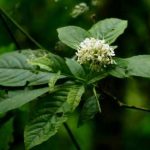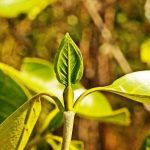TREE LIFE
MAY 2002
AS BEFORE PLEASE CONFIRM WITH ANY OF THE COMMITTEE MEMBERS THAT THE SCHEDULED OUTINGS AND WALKS WILL ACTUALLY TAKE PLACE. SEE THE BACK PAGE FOR PHONE NUMBERS.
THE ANNUAL SUBS WERE DUE ON 1ST APRIL. PLEASE PAY PROMPTLY AND ADVISE IF YOUR ADDRESS HAS CHANGED
MASHONALAND CALENDAR
Saturday 4th MayBotanic Garden Walk Please note the change of day for the walks during the winter. Meet in the car park of the Botanic Garden at 10.45 for 11 am where we will meet Tom and continue with the Rubiaceae family.
Sunday 19th May. A.G.M.
Ken and Sue Worsley have kindly offered to host the AGM at Mhowani Hills Farm close to town in Teviotdale. Please bring a chair and a contribution of a cake or snacks for tea at 9.15 am. The meeting will start promptly at 10.00am.
Saturday 25th May. It has been arranged that Mark’s Walk will again be in the grounds of the University of Zimbabwe. We will meet at 2.30 pm in the Vet Science car park which is most easily reached from the UZ gate on Churchill Avenue. Pick up a ticket from the guard at the booms, and drive on for about 500m. The entrance to the car park is the first (and second) turning on the left. To avoid missing the group please be punctual.
Saturday 1st June. Bot. Garden walk.
MATABELELAND CALENDAR
No arrangements have been made for May
CHAIRMAN’S REPORT TO THE AGM ON MAY 19TH, 2002
This is my report for the AGM to be held on May 19th 2002. This report therefore covers the period from the previous AGM on May 20th 2001 and my first year as Chairman of the Tree Society.
General
Nationally, the twelve month period consisted of continuing political uncertainty and escalating economic problems. Of particular concern to the Society is that commercial farms, on which there has been widespread lawlessness, are our main source of venues for our main outing on the third Sunday of each month and sometimes for the fourth Saturday walk as well.
Despite the problems, only one outing was cancelled (the 4th Saturday October outing to Lilfordia) although more use was made of places closer to Harare which are not commercial farms (for example, Ruwa Scout Park and Cleveland Dam).
Turning to economic matters and without wishing to pre-empt the Treasurer’s report, inflation rose steadily throughout the period, and stands currently at 113% per annum. As a generalization it is true to say that the Society’s main income is from subscriptions and its main expenditure is on the production of the monthly newsletter and in particular, stationery, printing and associated costs such as postage. The latter increased substantially during the year (for example letterheads for Tree Life increased from $5000 to $18000 and postage from $7 to $10 locally). The result is that having just set the new subscription at $400 per month from 1 April 2002 (which was itself a 100% increase) we are faced with an increase in printing costs alone of 120% and no doubt further substantial increases in postage etc. are to come.
The Society’s financial position was also weakened by the low interest rate policy which began in January 2001 and which resulted in interest rates below 20% p.a. as compared to the very high levels of inflation.
Clearly, our survival in the next 12 months will require some ingenuity on the part of the Committee and members but we are determined that the Society will survive and we look forward to everyone’s support.
There was also concern during the year that the widespread emigration which is taking place would affect our membership and indeed, our total membership (including 14 Associate members and 9 Honorary) has fallen from 226 in 2001 to 211 in 2002. However, in the circumstances, this could have been worse.
However, all was not doom and gloom during the year. For a start, we did manage to maintain to maintain nearly our full programme of outings at a rate of 3 per month, for the whole period. Even the Lilfordia meeting referred to earlier was replaced with a visit to St George’s College at short notice.
Branches
The only significant branch of the Society, the Matabeleland branch, was effectively mothballed during the year. Attendance at monthly outings had been very low for some time and it was decided that an attempt to maintain a committee structure and regular meetings would be abandoned. Informally, it was recommended that the members should join in with the Matopos Conservation Society but occasional Tree Society meetings and functions would continue.
Website
The website became functional some time after the 2001 AGM. We are most grateful to Mweb for providing this facility free of charge and especially to one of our members, Odette Lind of Mweb who designed and administers the site. The site has on it back numbers of Tree Life from January 2001 to date and has attracted a certain amount of international traffic, including some unusual enquiries. For example, someone in UK watching an international cricket match emailed to ask what the “trees with blue leaves” were.
During the year, some members asked for Tree Life to be emailed to them. Maureen has managed this but it has met with mixed success.
Calendar
A full program of outings took place. I have not repeated them here as they have been written up in detail in Tree Life. However, a special mention must be made of the Nyanga outing in January/February 2002. This attracted a record number of members (over 30 on some days) and we were honoured with the presence of Tom Muller.
The 2002 Easter trip was to a very special place, Besna Kobila in the Eastern Matopos. Apart from the variety of trees, the extensive vleis were rich in interesting species, some with an E Districts flavour.
One innovation during the year was an evening talk given by Cathy Sharp on fungi. This proved a success and the format may be repeated if we can find suitable speakers.
Tree mapping
The Society’s programme to map the trees of Zimbabwe on a quarter degree square basis continues to make progress thanks to the efforts of Maureen. During the year, some better mapping software was purchased from the UK. I would like to thank both Maureen and Fr Brendan Conway for their work in getting the new system up and running.
Thanks
The operation of a Society such as this one involves much behind-the scenes work and I would like to thank everyone who has helped.
I would particularly thank the hard-working committee. Lyn Mullin, my deputy chairman, has made a major contribution with the “In Retrospect” series in Tree Life, has written numerous articles, has prepared a checklist of vernacular plant names and helped in various other ways. Our hardworking treasurer, Rose Greig, has as usual done stalwart work with our finances despite the difficult conditions. John Wilson, as “Minister without portfolio” has undertaken a number of special exercises for us and has provided wise counsel. Lastly, but by no means least, Maureen Silva-Jones who is the linchpin of the Society and has kept the whole thing on the road by editing Tree Life, dealing with our correspondence, running the mapping exercise and importantly keeping the Chairman from neglecting his duties.
Our special thanks go to Vida Siebert, who every month, quietly and without publicity, undertakes the tedious but vital work of collating and posting Tree Life.
On the botanical front, I would like to thank Tom Muller for once again leading our monthly botanic garden walks, as he has now done for many years. A very welcome innovation this year has been his presence at three Tree Society outings: the Christmas Social at which he acted as leader, the February 2002 Nyanga trip and one of my walks. We were very privileged to have instant access to his knowledge of woody plants.
In Bulawayo, Jonathan Timberlake has done much sterling work for the Matabeleland branch and his advice and influence has extended to the Society nationally. During the year we lost Anthon Ellert, the Chairman of the Matabeleland Branch who emigrated to Arizona. I would particularly like to thank him for his contribution to the Society over many years.
I would also like to thank:
- all the landowners and institutions who allowed us to visits their properties and in many cases provided a warm welcome and hospitality as well;
- the Botanic Gardens for allowing us free access for the monthly walks;
- Bob Drummond for acting as our advisor in botanical matters;
- Meg Coates Palgrave for assisting the Society in various ways;
- Bill Clarke for once again hosting our Christmas Social; and
- all the contributors to Tree Life for their articles so willingly written, and subsequently enjoyed by all members.
FINALLY
The next year is bound to be a challenging one as no answer seems likely to the national problems referred to earlier. A special effort will be needed to ensure that the Society continues to survive and flourish.
-Mark Hyde Chairman
CLEVELAND DAM: 17 FEBRUARY 2002
The choice of our February outing was a spot close to town within the Cleveland Dam area. We parked our cars near to the entrance of Haka game park and walked at the usual Tree Society pace (slow to very slow!) towards the edge of the dam.
Outings close to town often do not attract many people but turn-out was good (approximately 25 people) and a wonderful day in surprisingly thick and wild-looking bush was enjoyed by those attending. After the very long dry spell with almost no rain for many days, some of the ground flora was looking a bit scruffy but the trees themselves seemed generally to be in good condition.
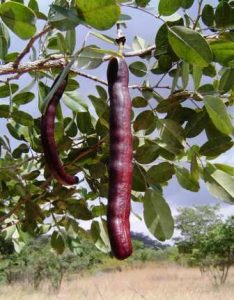
Swartzia madagascariensis. Photo: Bart Wursten. Source: Flora of Zimbabwe
The main features of Cleveland are of quite high altitude (over 1500 m) and miombo woodland in sandy soils. Two trees we saw which are typical of sandveld, namely Burkea africana and Swartzia madagascariensis (the Snake bean) are trees that Tom has been unable to grow in the Botanic Gardens – the red soils there are quite unsuitable. In order to get the Kalahari sand species Baikiaea plurijuga to grow there many tons of sand had to be delivered in which to plant the tree.
A specimen of Strychnos cocculoides (Corky-bark monkey orange) was found with magnificent, extremely thick, corky bark. Also seen was Diospyros lycioides (Red star-apple). This is of course a species we often see around Harare but a glance at the map in Coates Palgrave shows that it occurs very widely over southern Africa. Across this range there is considerable variation which is usually treated as subspecies of one very variable species. Our plant is subsp. sericea with silky-hairy leaves while in the south we get subsp. lycioides with leaves which are almost glabrous.
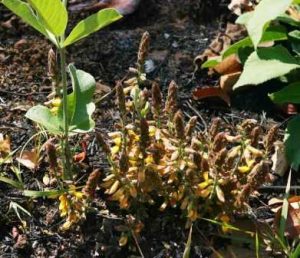
Eriosema englerianum. Photo: Bart Wursten. Soure: Flora of Zimbabwe
A common suffrutex seen was the legume Eriosema englerianum; this can be distinguished by its largish 3-foliolate leaves which are almost sessi
le so that the lower pair of leaflets almost meet the stem. Also in the woodland was Protea gaguedi. This is the species with long narrow leaves which are almost entirely without hairs. It looks a bit like P. welwitschii which has brown-hairy leaves with which it sometimes appears to intergrade leading to puzzling intermediates.
Also naturalised in the woodland was Pinus roxburghii, identified by Lyn Mullin. Although tree lists of Zimbabwe have had P. patula on them for many years, it is clear that a number of other species of pine are also quite well naturalised, mainly in the E Districts. However, P. roxburghii is a fairly common escape around Harare.
Eventually we approached the edge of the dam. Throughout the woodland we had seen another common suffrutex, Lannea edulis with its typical pinnate leaves. In a bare sandy area we came across the form with simple leaves. This is an extraordinary variant of the normal pinnate form. Incidentally, although I call this taxon a form, I’m really not sure what rank it should be treated at – it might be a good species for all I know. A very striking legume with large yellow flowers was a species of Crotalaria. In the marginal reeds of the dam was a naturalised sapling of a Eucalyptus which Lyn Mullin named provisionally as E. tereticornis. There is no doubt that gums do escape in a small way from time to time.
Other species seen included Ekebergia benguelensis, Monotes engleri, Pavetta gardeniifolia, Pterocarpus angolensis, Uapaca kirkiana, Turraea nilotica and Vangueria infausta.
An interesting plant seen in the shade of some woodland is the parasitic species Orobanche minor. This is typically a brown plant (no chlorophyll) with purplish flowers. It occurs from time to time around Harare (for example in the Botanic Gardens).
Lunch took place in some thick woodland in pleasant shade. After lunch a small group walked towards the picnic area of Cleveland. The area had not been cut so there were some splendid very tall thatching grasses and perhaps the most interesting tree was a colony of exceptionally tall Dovyalis zeyheri growing around a rocky hill.
On the way back to the cars, we found a rather local alien grass which occurs sometimes around Harare – Harpachne schimperi. Although its most prolific site is on the Airport Road (watch out for the reddish toothbrush-like heads when you drive out that way – it can easily be seen from a car), it has also been recorded from Danhiko, which is quite close to Cleveland.
All in all it was a day which illustrated how, even in spots close to home which we should know well, there is always something of interest to be discovered.
-Mark Hyde
RUWA SCOUT PARK: 17 MARCH 2002
The venue for our outing in March was the Scout Park at Ruwa which we visited with the kind permission of the Boy Scouts Association. Although there are a considerable number of planted and naturalised exotics, it remains an interesting place with some nice vegetation.
A fairly small group of members gathered on the day and we began by walking towards the Ruwa River through what is effectively sandy miombo woodland. The vegetation was not unlike that at Cleveland Dam the previous month.
As we started, an interesting diversion was provided by some Orange Dog caterpillars munching away at some small planted lemon trees. Mary Toet explained that these are the larvae of the Citrus Swallowtail and are pests of citrus. She also showed how, if the caterpillar is annoyed, it rears up at the front; what appeared to happen was a fork-shaped object which is normally tucked away, unsheathes itself and is thrust forward and upwards. We also confirmed that the caterpillars give off a strong and unpleasant odour.
Into the sandy woodland, we encountered a Swartzia madagascariensis (Snake bean tree). This of course raises the question as to what should we call it. To Bobgunnia or not to Bobgunnia, that was the question, and never having seen the original paper on which the change is based, it’s a difficult one to answer.
The Makoni tea bush also gave rise to some discussion. Someone (and I’m sorry to say I forget who) reported that this is now being sold commercially. The technique is to allow the leaves to dry on the plant, at which stage they turn black and are picked. They are then sold through upmarket supermarkets.
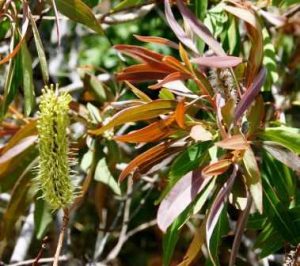
Faurea saligna. Photo: Bart Wursten. Source: Flora of Zimbabwe
Near to the river we encountered the ubiquitous Ageratina adenophora. Hardly any of our outings these days are free from this extremely successful weed. Near to the river we found Rhamnus prinoides with its exceptionally glossy leaves, Syzygium cordatum, Faurea saligna and in the dam itself was a floating Nymphoides.
An interesting discussion took place about curry. The curry bush of Nyanga is Hypericum revolutum, which we didn’t see that day. But, in addition, the semi-shrubby Helichrysum kraussii which is so common in sandy and degraded places and was certainly plentiful at Ruwa, is also called a curry bush and is certainly an aromatic plant.
On through the sandy woodland, we saw some fine specimens of Ochna pulchra with their very characteristic pealing bark, Crotalaria pallidicaulis, here a large shrub, was common and the shrubby Grewia decemovulata was also found. Further along, we emerged onto a rocky area adjacent to the river; there were the leafless trailing stems of Sarcostemma viminale, some fine Englerophyton magalismontanum, the climbing stems of Tinospora caffra, Hymenodictyon floribundum and the remains of an orchid, Eulophia streptopetala.
In the afternoon, we walked the other way along the river. Here in a vlei we found some Kniphofia linearifolia (Red-hot pokers) and the fruits of a species of Aristea, presumably angolensis. A fairly wide selection of trees was found as we walked back though woodland and a number of additions were made to the morning’s list. Examples were: Osyris lanceolata, Clerodendrum myricoides, Protea angolensis and Celtis africana.
The day ended in a surprisingly heavy shower of rain, the first significant rain for some time in this extraordinarily dry season. On returning home to Alexandra Park, virtually nothing had fallen – nothing measurable at least.
I would like to thank the Scouts Association for allowing us to visit Ruwa. We hope to visit it again at some stage.
-Mark Hyde
BOTANIC GARDEN WALK: 9 APRIL 2002
The subject was once again, Rubiaceae. We had a rather low turnout for some reason and we were not even into double figures including Tom. However, what we lacked in numbers was made up for in enthusiasm and interest.
The first species seen was Psydrax livida. This is a common species which we often encounter on our outings around Harare; a specific feature is its green twigs. It is not too different from Vangueria infausta but the leaves are a different shade of green and more glossy. Tom explained that it is a feature of granite country, often but not always in rocky places, and occurs at a wide range of altitudes from low through medium to high altitudes.
The well known and striking Hymenodictyon floribundum (Fire bush) was looked at next. As we all know, it is called the Fire bush because of its striking autumnal coloration, which was in evidence in this specimen. It is a species of rocky places, growing in cracks of rocks and thin soil over rocks, and is generally common.
Over near the E Districts section we encountered a striking climbing species which has flowers in heads. This was Cephalanthus natalensis. Here it was a straggling subclimber but Tom mentioned that in the wild it could form a very stout rope. A specific feature was the presence of domatia in the axils of the leaves.
On to the not-so-easy genus Vangueria. We looked at Vangueria apiculata which has large, glossy, hairless leaves. It is mainly an E Districts species but comes some way westward along the watershed into Wedza and Makoni Districts. Tom explained that its habitat was the microphyllous, fynbos-type of vegetation which we get in the east. Hairy forms of this species, which we had seen during the Nyanga visit in February, were now called Vangueria volkensii.
Two further species may cause confusion. Firstly, Vangueria esculenta, which is another E Districts species, occurs in a different type of habitat, namely as an understorey forest tree. Secondly, Vangueria randii, which is a fairly common species of termite mounds in savannah woodland, is rather similar to V. apiculata, but its leaves tend to be smaller and less glossy.
On next to Canthium mundianum. Canthium is a not-so-familiar genus to the Tree Society. Of the 11 species which occur in Zimbabwe, only three occur in the C Division; these are C. glaucumsubsp.frangula, C. lactescens and C. setiflorum. Furthermore, C, setiflorum is extremely rare and C. glaucum occurs generally at mid and lower altitudes, so the only common one is C. lactescens.
Today, Tom showed us C, mundianum, a species of forest outliers, mainly in the Eastern division but also occurring at Buchwa Mountain. Also the small leaves of C. setiflorum with appressed hairs on the young twigs.
Another species of outliers is Tricalysia congesta, formerly called T. ruandensis. Its most noticeable feature is the glabrous and glossy leaves; we see this quite often as it grows at Domboshawa.
Finally, we searched in the gathering gloom, for the small obovate, shiny leaves of Coddia rudis (formerly known as Xeromphis rudis) and eventually found it.
Once again, our great th
BAOBABS IN MY SOUP Continued. By Lyn Mullin.
Two trees at the eastern end of Lake Ngami have vanished. Livingstone recorded the girth of one at 76 feet [23.16 m], and Baines referred to it as “Livingstone’s tree”. We were informed by Julian Marshall, the Fisheries Officer at Maun, that the remains of a giant baobab were still visible near Toten, and that the tree could not have been dead more than two or three years.
Further north, Baines and Chapman measured another tree, which so far we have been unable to find. Stereo pairs of air survey pictures of the pan where they camped do not show any large trees, but only a check on the ground will make certain whether or not it is still growing.
Baines and Chapman crossed the Pandamatenga road and went more directly north than other travellers, and in March 1863 they measured this tree, “57 feet [17.37 m] breast high and 65 feet [19.81 m] at the ground. It is now in Hwange National Park at Dandari Pan.
Baines was a careful and accurate man in all respects, and he kept very careful records of latitude, but he could not keep a watch or clock under his conditions of travel, so one can only rely on latitude in following his old routes. It is a singularly unrewarding occupation in that dry, sandy, flat forest running up and down the lines of latitude looking for trees, unless there is some other feature with which to link them.
Still in the same area there was another well-known baobab at Cream of Tartar Pan on the Pandamatenga road, which was variously measured at 27 yards [24.69 m], 25 yards [22.86 m], and 80 feet [24.38 m] circumference. We travelled by dead reckoning and reached a pan called Sebuyu, but there was no baobab of that size in sight. There was a much scarred, small tree of 24 feet 9 inches [7.54 m] girth at breast height, with dozens of initials carved on it, but none we have been able to identify. [See The Baobab of Sibuyu Pan, above; this tree had a girth of 7.95 m at breast height in June 1987.]
With the diminution in rainfall over the past 100 years, it is possible that we were at the wrong pan; on modern maps a much larger pan is shown to the north and east of Sebuyu which may have been the waterpoint of early travellers. Sebuyu was quite dry when we saw it in September 1966, but at this stage a burnt-out generator and fuel shortage started us homeward, and we must make a further search for this tree at some future time.
[Comment: The correct name of this pan is Sibuyu, not Sebuyu. The very large number of names and initials carved into the small baobab at Sibuyu makes it certain that this pan was an important camping site and watering point for the early travellers, and it must have had a reliable supply of water in the latter half of the 19th century. It was dry in June 1987, and with the diminution of rainfall since the days of the early travellers, it possibly now holds water only during good rainy seasons.] We eventually (March 1967) found what is probably another measured tree at the southeast corner of the Makgadikgadi Pan. This one was first measured by Emil Holub in 1875, and tracing it meant finding the old hunters’ road along the eastern edge of the pan. Things have not altered much in Botswana, and the old road is still used in part by modern transport, winding down the escarpment from the Makwe Plain. The first place to find was Bergfontein or Nokane Spring, still known under the latter name. This corresponds with the Dinokane of other travellers, and is on the old wagon road which is easily negotiable today by Landrover; no trees of any size have sprung up on it, and the cleared way is easily discernible except in two or three places in mopane scrub. The spring is a pleasant place in that dry country, with large trees overhanging the two pools, and it is much frequented by game and cattle. We saw fresh leopard spoor as well.When the road enters the pan it turns east of north, and about two miles away there is a baobab, the first large one near the old road; there are two much younger ones before it. Holub’s description, “It was at the saltpan that I saw my first baobab, the most southerly specimen along my route”, strongly points to this tree as being the one he measured. The one I noticed was 25 feet [7.62 m] in height, its circumference measuring nearly 52 feet [15.85 m]. There are no other baobabs of any size for at least three miles [5 km] beyond this one: westwards along the pan from the road there are larger specimens, but Holub wrote only of the eastern shore and the road went east and north.
If this is indeed Holub’s tree it, too, has grown very little. At a convenient height from the ground it is 54 feet 8 inches in girth [16.67 m], and measured at breast height from the upper side of the slight slope on which it stands it is exactly 52 feet now [15.85 m]; its height is just over 30 feet [9.14 m] today. (Height measurements, unless made by a forester or surveyor, are always subject to suspicion, as very few people know how they should be done).
We do not think it worth searching for the tree measured by Richard Frewen: it was some 7 miles [11.3 km] from the Berg, but no other means of identifying it are given.
Yet one more [baobab] lay on the old wagon track, and Schultz gave its diameter in 1875 as 32 feet [9.75 m]. If this large tree still exists it may be possible to find it, as its position is fairly well described.
To be continued.
TREE SOCIETY: THE FINANCIAL POSITION Mark Hyde – Chairman
The purpose of this message is to report to you on the financial position of the Society, which appears to be worse than we had realised.
Maureen reports that about 25% of the subscriptions have come in so far but that money is being rapidly spent on the now much higher cost of Tree Life and such things as the 8000 letterheads which cost $ 18 000. Rose has prepared a budget based on 200 paying members which showed what the subscriptions ought to be depending on the size of Tree Life each month. The results were as follows:
| Tree Life sides (= sheets of paper 2) | Break-even subscription |
| 6 | $500 |
| 8 | $560 |
| 10 | $620 |
| 12 | $700 |
The actual subscriptions are $400 p.a. so we already have a serious shortfall. Furthermore, if other costs rise unexpectedly which is not unlikely, even the subscriptions mentioned above may be inadequate. In order to carry on producing an 8-page Tree Life throughout the year, an additional $ 32 000 would be needed. Indeed, more would be ideal in order to cushion us against any further cost increases which may take place.
At the Committee meeting on 16th April, we discussed what options are available to us. They appeared to be as follows:
| Option | Comment |
| 1. Increase the subscriptions now | This will be difficult given that we have only just set the rate for this year. |
| 2. Levy all the members with an extra subscription later in the year – say from 1 October 2002. | There is no precedent for this and it may well be difficult to get all members to pay. |
| 3. Cut back on Tree Life – either fewer pages and/or less frequent issues – e.g. bi-monthly or quarterly | The Committee felt quite strongly that this was not desirable. |
| 4. Fund raising for the Society | Ideas needed. |
| 5. Sponsorship | E.g. would any company sponsor an edition of Tree Life in return for some advertising. |
| 6. Allow advertising in Tree Life | Up to now we have avoided this – but should we think again? |
| 7. Request donations | A variant of 4. Above. |
| 8. Sell information | Do we have anything of commercial value? |
| 9. Produce Tree Life more cheaply | Maureen has already looked around for cheaper providers but Canon seem to be very competitive. |
In the meantime, I would like to ask all members to do the following:
- pay their subscriptions as soon as possible (this will aid the short term cash flow);
- if possible, make a donation to the Society. I appreciate that times are hard and that this may simply not be possible so don’t worry if this is not feasible
- consider whether we should allow advertising in the newsletter and/or sponsorship of a discrete sort.
We shall be discussing these issues at the AGM on 19th May. Please come, if you can to the meeting.
MARK HYDE CHAIRMAN


